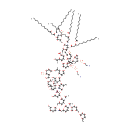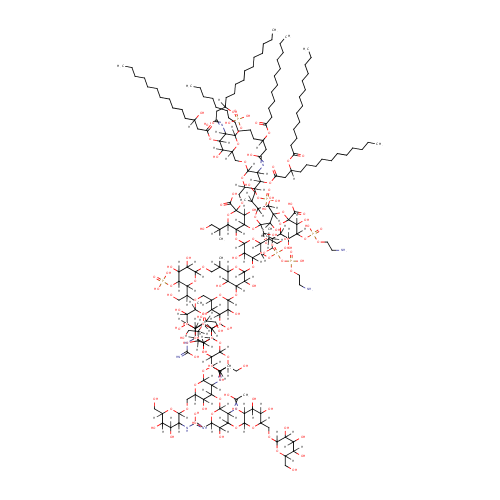
LPS (1-O-antigen) (PAMDB001504)
| Record Information | ||||||||||||||||||||||||||||||||||||||||||||||
|---|---|---|---|---|---|---|---|---|---|---|---|---|---|---|---|---|---|---|---|---|---|---|---|---|---|---|---|---|---|---|---|---|---|---|---|---|---|---|---|---|---|---|---|---|---|---|
| Version | 1.0 | |||||||||||||||||||||||||||||||||||||||||||||
| Update Date | 1/22/2018 11:54:54 AM | |||||||||||||||||||||||||||||||||||||||||||||
| Metabolite ID | PAMDB001504 | |||||||||||||||||||||||||||||||||||||||||||||
| Identification | ||||||||||||||||||||||||||||||||||||||||||||||
| Name: | LPS (1-O-antigen) | |||||||||||||||||||||||||||||||||||||||||||||
| Description: | Lipopolysaccharides (LPS), also known as lipoglycans, are large molecules consisting of a lipid and a polysaccharide joined by a covalent bond; they are found in the outer membrane of Gram-negative bacteria, act as endotoxins and elicit strong immune responses in animals. LPS consists of three parts: O antigen (or O polysaccharide), core polysaccharide and lipid A.When LPS contains a repetitive glycan polymer this is referred to as the O antigen, O polysaccharide, or O side chain of the bacteria. LPS (1-o-antigen) contains only one unit of O antigen. The O antigen is attached to the core oligosaccharide, and comprises the outermost domain of the LPS molecule. The composition of the O chain varies from strain to strain, for example there are over 160 different O antigen structures produced by different Pseudomonas aeruginosa strains. The presence or absence of O chains determine whether the LPS is considered rough or smooth. Full length O-chains would render the LPS smooth while the absence or reduction of O-chains would make the LPS rough. Bacteria with rough LPS usually have more penetrable cell membranes to hydrophobic antibiotics since a rough LPS is more hydrophobic. O antigen is exposed on the very outer surface of the bacterial cell, and as a consequence, is a target for recognition by host antibodies. | |||||||||||||||||||||||||||||||||||||||||||||
| Structure | ||||||||||||||||||||||||||||||||||||||||||||||
| Synonyms: |
| |||||||||||||||||||||||||||||||||||||||||||||
| Chemical Formula: | C215H386N10O123P6 | |||||||||||||||||||||||||||||||||||||||||||||
| Average Molecular Weight: | 5265.2011 | |||||||||||||||||||||||||||||||||||||||||||||
| Monoisotopic Molecular Weight: | 5262.26826998 | |||||||||||||||||||||||||||||||||||||||||||||
| InChI Key: | CWWMHIJTLCZEJI-UHFFFAOYSA-N | |||||||||||||||||||||||||||||||||||||||||||||
| InChI: | InChI=1S/C215H386N10O123P6/c1-15-21-27-33-39-45-46-52-58-64-70-76-130(245)311-114(74-68-62-56-50-43-37-31-25-19-5)84-132(247)325-177-138(223-128(243)83-113(73-67-61-55-49-42-36-30-24-18-4)310-129(244)75-69-63-57-51-44-38-32-26-20-6)194(304-100-124-147(256)174(324-131(246)82-112(241)72-66-60-54-48-41-35-29-23-17-3)137(198(320-124)347-351(293,294)295)222-127(242)81-111(240)71-65-59-53-47-40-34-28-22-16-2)323-126(173(177)343-349(287,288)289)102-307-213(208(279)280)192(278)188(342-214(209(281)282)190(276)183(162(271)168(338-214)103(7)85-226)341-215(210(283)284)191(277)184(345-352(296,297)308-79-77-216)163(272)169(339-215)104(8)86-227)186(172(340-213)107(11)89-230)336-205-166(275)181(187(171(328-205)106(10)88-229)346-354(300,301)348-353(298,299)309-80-78-217)334-204-165(274)179(161(270)167(326-204)108(12)97-302-201-160(269)156(265)182(344-350(290,291)292)170(327-201)105(9)87-228)331-203-164(273)178(149(258)125(322-203)101-306-200-158(267)153(262)142(251)118(93-234)316-200)332-206-185(155(264)143(252)119(94-235)317-206)335-207-189(337-195-134(225-212(219)286)151(260)140(249)116(91-232)313-195)180(146(255)121(96-237)318-207)333-197-136(221-110(14)239)176(148(257)123(319-197)99-303-193-133(224-211(218)285)150(259)139(248)115(90-231)312-193)329-196-135(220-109(13)238)175(145(254)120(95-236)314-196)330-202-159(268)154(263)144(253)122(321-202)98-305-199-157(266)152(261)141(250)117(92-233)315-199/h103-108,111-126,133-207,226-237,240-241,248-278H,15-102,216-217H2,1-14H3,(H,220,238)(H,221,239)(H,222,242)(H,223,243)(H,279,280)(H,281,282)(H,283,284)(H,296,297)(H,298,299)(H,300,301)(H3,218,224,285)(H3,219,225,286)(H2,287,288,289)(H2,290,291,292)(H2,293,294,295) | |||||||||||||||||||||||||||||||||||||||||||||
| CAS number: | Not Available | |||||||||||||||||||||||||||||||||||||||||||||
| IUPAC Name: | (2R,3S,4R,5R,6R)-5-{[(3S,4R,5R,6R)-5-[({[(2-aminoethoxy)(hydroxy)phosphoryl]oxy}(hydroxy)phosphoryl)oxy]-4-{[(3S,4S,5R,6R)-4-{[(3R,4S,5R,6R)-4-{[(2R,3R,4S,5R,6R)-3-{[(3R,4S,5R,6R)-3-{[(2S,3R,4R,5S,6R)-4,5-dihydroxy-3-[(C-hydroxycarbonimidoyl)amino]-6-(hydroxymethyl)oxan-2-yl]oxy}-4-{[(2S,3R,4R,5R,6R)-6-({[(2R,3R,4R,5S,6R)-4,5-dihydroxy-3-[(C-hydroxycarbonimidoyl)amino]-6-(hydroxymethyl)oxan-2-yl]oxy}methyl)-5-hydroxy-4-{[(2R,3R,4R,5R,6R)-5-hydroxy-3-[(1-hydroxyethylidene)amino]-6-(hydroxymethyl)-4-{[(2S,3R,4S,5R,6R)-3,4,5-trihydroxy-6-({[(2S,3R,4S,5R,6R)-3,4,5-trihydroxy-6-(hydroxymethyl)oxan-2-yl]oxy}methyl)oxan-2-yl]oxy}oxan-2-yl]oxy}-3-[(1-hydroxyethylidene)amino]oxan-2-yl]oxy}-5-hydroxy-6-(hydroxymethyl)oxan-2-yl]oxy}-4,5-dihydroxy-6-(hydroxymethyl)oxan-2-yl]oxy}-3,5-dihydroxy-6-({[(2S,3R,4S,5R,6R)-3,4,5-trihydroxy-6-(hydroxymethyl)oxan-2-yl]oxy}methyl)oxan-2-yl]oxy}-6-[(2S)-1-{[(3S,4R,5S,6R)-3,4-dihydroxy-6-[(2S)-1-hydroxypropan-2-yl]-5-(phosphonooxy)oxan-2-yl]oxy}propan-2-yl]-3,5-dihydroxyoxan-2-yl]oxy}-3-hydroxy-6-[(2S)-1-hydroxypropan-2-yl]oxan-2-yl]oxy}-4-{[(2S,3S,4S,5R,6R)-4-{[(2S,3S,4S,5R,6R)-4-{[(2-aminoethoxy)(hydroxy)phosphoryl]oxy}-2-carboxy-3,5-dihydroxy-6-[(2S)-1-hydroxypropan-2-yl]oxan-2-yl]oxy}-2-carboxy-3,5-dihydroxy-6-[(2S)-1-hydroxypropan-2-yl]oxan-2-yl]oxy}-2-{[(2R,3S,4R,5R,6R)-6-{[(2R,3S,4R,5R,6R)-5-{[(3R)-1,3-dihydroxytetradecylidene]amino}-3-hydroxy-4-{[(3R)-3-hydroxytetradecanoyl]oxy}-6-(phosphonooxy)oxan-2-yl]methoxy}-5-{[(3R)-3-(dodecanoyloxy)-1-hydroxytetradecylidene]amino}-3-(phosphonooxy)-4-{[(3R)-3-(tetradecanoyloxy)tetradecanoyl]oxy}oxan-2-yl]methoxy}-3-hydroxy-6-[(2S)-1-hydroxypropan-2-yl]oxane-2-carboxylic acid | |||||||||||||||||||||||||||||||||||||||||||||
| Traditional IUPAC Name: | (2R,3S,4R,5R,6R)-5-{[(3S,4R,5R,6R)-5-({[2-aminoethoxy(hydroxy)phosphoryl]oxy(hydroxy)phosphoryl}oxy)-4-{[(3S,4S,5R,6R)-4-{[(3R,4S,5R,6R)-4-{[(2R,3R,4S,5R,6R)-3-{[(3R,4S,5R,6R)-3-{[(2S,3R,4R,5S,6R)-4,5-dihydroxy-3-(C-hydroxycarbonimidoylamino)-6-(hydroxymethyl)oxan-2-yl]oxy}-4-{[(2S,3R,4R,5R,6R)-6-({[(2R,3R,4R,5S,6R)-4,5-dihydroxy-3-(C-hydroxycarbonimidoylamino)-6-(hydroxymethyl)oxan-2-yl]oxy}methyl)-5-hydroxy-4-{[(2R,3R,4R,5R,6R)-5-hydroxy-3-[(1-hydroxyethylidene)amino]-6-(hydroxymethyl)-4-{[(2S,3R,4S,5R,6R)-3,4,5-trihydroxy-6-({[(2S,3R,4S,5R,6R)-3,4,5-trihydroxy-6-(hydroxymethyl)oxan-2-yl]oxy}methyl)oxan-2-yl]oxy}oxan-2-yl]oxy}-3-[(1-hydroxyethylidene)amino]oxan-2-yl]oxy}-5-hydroxy-6-(hydroxymethyl)oxan-2-yl]oxy}-4,5-dihydroxy-6-(hydroxymethyl)oxan-2-yl]oxy}-3,5-dihydroxy-6-({[(2S,3R,4S,5R,6R)-3,4,5-trihydroxy-6-(hydroxymethyl)oxan-2-yl]oxy}methyl)oxan-2-yl]oxy}-6-[(2S)-1-{[(3S,4R,5S,6R)-3,4-dihydroxy-6-[(2S)-1-hydroxypropan-2-yl]-5-(phosphonooxy)oxan-2-yl]oxy}propan-2-yl]-3,5-dihydroxyoxan-2-yl]oxy}-3-hydroxy-6-[(2S)-1-hydroxypropan-2-yl]oxan-2-yl]oxy}-4-{[(2S,3S,4S,5R,6R)-4-{[(2S,3S,4S,5R,6R)-4-{[2-aminoethoxy(hydroxy)phosphoryl]oxy}-2-carboxy-3,5-dihydroxy-6-[(2S)-1-hydroxypropan-2-yl]oxan-2-yl]oxy}-2-carboxy-3,5-dihydroxy-6-[(2S)-1-hydroxypropan-2-yl]oxan-2-yl]oxy}-2-{[(2R,3S,4R,5R,6R)-6-{[(2R,3S,4R,5R,6R)-5-{[(3R)-1,3-dihydroxytetradecylidene]amino}-3-hydroxy-4-{[(3R)-3-hydroxytetradecanoyl]oxy}-6-(phosphonooxy)oxan-2-yl]methoxy}-5-{[(3R)-3-(dodecanoyloxy)-1-hydroxytetradecylidene]amino}-3-(phosphonooxy)-4-{[(3R)-3-(tetradecanoyloxy)tetradecanoyl]oxy}oxan-2-yl]methoxy}-3-hydroxy-6-[(2S)-1-hydroxypropan-2-yl]oxane-2-carboxylic acid | |||||||||||||||||||||||||||||||||||||||||||||
| SMILES: | [H][C@@](O)(CCCCCCCCCCC)CC(=O)O[C@@]1([H])[C@]([H])(O)[C@@]([H])(CO[C@]2([H])O[C@]([H])(CO[C@]3(O[C@]([H])([C@@]([H])(C)CO)[C@@]([H])(OC4([H])O[C@]([H])([C@@]([H])(C)CO)[C@@]([H])(OP(O)(=O)OP(O)(=O)OCCN)[C@]([H])(OC5([H])O[C@]([H])([C@@]([H])(C)COC6([H])O[C@]([H])([C@@]([H])(C)CO)[C@@]([H])(OP(O)(O)=O)[C@]([H])(O)[C@]6([H])O)[C@@]([H])(O)[C@]([H])(OC6([H])O[C@]([H])(CO[C@@]7([H])O[C@]([H])(CO)[C@]([H])(O)[C@]([H])(O)[C@@]7([H])O)[C@@]([H])(O)[C@]([H])(O[C@@]7([H])O[C@]([H])(CO)[C@]([H])(O)[C@]([H])(O)[C@@]7([H])OC7([H])O[C@]([H])(CO)[C@@]([H])(O)[C@]([H])(O[C@]8([H])O[C@]([H])(CO[C@]9([H])O[C@]([H])(CO)[C@@]([H])(O)[C@]([H])(O)[C@@]9([H])NC(O)=N)[C@]([H])(O)[C@]([H])(O[C@]9([H])O[C@]([H])(CO)[C@]([H])(O)[C@]([H])(O[C@@]%10([H])O[C@]([H])(CO[C@@]%11([H])O[C@]([H])(CO)[C@]([H])(O)[C@]([H])(O)[C@@]%11([H])O)[C@]([H])(O)[C@]([H])(O)[C@@]%10([H])O)[C@@]9([H])N=C(C)O)[C@@]8([H])N=C(C)O)[C@@]7([H])O[C@]7([H])O[C@]([H])(CO)[C@@]([H])(O)[C@]([H])(O)[C@@]7([H])NC(O)=N)[C@@]6([H])O)[C@]5([H])O)[C@]4([H])O)[C@]([H])(O[C@]4(O[C@]([H])([C@@]([H])(C)CO)[C@@]([H])(O)[C@]([H])(O[C@]5(O[C@]([H])([C@@]([H])(C)CO)[C@@]([H])(O)[C@]([H])(OP(O)(=O)OCCN)[C@]5([H])O)C(O)=O)[C@]4([H])O)C(O)=O)[C@]3([H])O)C(O)=O)[C@@]([H])(OP(O)(O)=O)[C@]([H])(OC(=O)C[C@@]([H])(CCCCCCCCCCC)OC(=O)CCCCCCCCCCCCC)[C@@]2([H])N=C(O)C[C@@]([H])(CCCCCCCCCCC)OC(=O)CCCCCCCCCCC)O[C@]([H])(OP(O)(O)=O)[C@]1([H])N=C(O)C[C@]([H])(O)CCCCCCCCCCC | |||||||||||||||||||||||||||||||||||||||||||||
| Chemical Taxonomy | ||||||||||||||||||||||||||||||||||||||||||||||
| Taxonomy Description | This compound belongs to the class of organic compounds known as polysaccharides. These are compounds containing more than ten saccharide units. | |||||||||||||||||||||||||||||||||||||||||||||
| Kingdom | Organic compounds | |||||||||||||||||||||||||||||||||||||||||||||
| Super Class | Organic Polymers | |||||||||||||||||||||||||||||||||||||||||||||
| Class | Polysaccharides | |||||||||||||||||||||||||||||||||||||||||||||
| Sub Class | Not Available | |||||||||||||||||||||||||||||||||||||||||||||
| Direct Parent | Polysaccharides | |||||||||||||||||||||||||||||||||||||||||||||
| Alternative Parents |
| |||||||||||||||||||||||||||||||||||||||||||||
| Substituents |
| |||||||||||||||||||||||||||||||||||||||||||||
| Molecular Framework | Aliphatic heteromonocyclic compounds | |||||||||||||||||||||||||||||||||||||||||||||
| External Descriptors | Not Available | |||||||||||||||||||||||||||||||||||||||||||||
| Physical Properties | ||||||||||||||||||||||||||||||||||||||||||||||
| State: | Solid | |||||||||||||||||||||||||||||||||||||||||||||
| Charge: | -3 | |||||||||||||||||||||||||||||||||||||||||||||
| Melting point: | Not Available | |||||||||||||||||||||||||||||||||||||||||||||
| Experimental Properties: |
| |||||||||||||||||||||||||||||||||||||||||||||
| Predicted Properties |
| |||||||||||||||||||||||||||||||||||||||||||||
| Biological Properties | ||||||||||||||||||||||||||||||||||||||||||||||
| Cellular Locations: | Cytoplasm | |||||||||||||||||||||||||||||||||||||||||||||
| Reactions: | UDP-Glucose + LPS (1-O-antigen) <> Uridine 5'-diphosphate + D-Glucosyllipopolysaccharide Uridine diphosphategalactose + LPS (1-O-antigen) > Uridine 5'-diphosphate + 3-alpha-D-galactosyl-[lipopolysaccharide glucose] UDP-Glucose + LPS (1-O-antigen) > Uridine 5'-diphosphate + D-glucosyl-lipopolysaccharide Uridine diphosphate-N-acetylglucosamine + LPS (1-O-antigen) > Uridine 5'-diphosphate + N-acetyl-D-glucosaminyllipopolysaccharide Uridine diphosphate-N-acetylglucosamine + LPS (1-O-antigen) <> Uridine 5'-diphosphate | |||||||||||||||||||||||||||||||||||||||||||||
| Pathways: | ||||||||||||||||||||||||||||||||||||||||||||||
| Spectra | ||||||||||||||||||||||||||||||||||||||||||||||
| Spectra: | ||||||||||||||||||||||||||||||||||||||||||||||
| References | ||||||||||||||||||||||||||||||||||||||||||||||
| References: |
| |||||||||||||||||||||||||||||||||||||||||||||
| Synthesis Reference: | Not Available | |||||||||||||||||||||||||||||||||||||||||||||
| Material Safety Data Sheet (MSDS) | Not Available | |||||||||||||||||||||||||||||||||||||||||||||
| Links | ||||||||||||||||||||||||||||||||||||||||||||||
| External Links: |
| |||||||||||||||||||||||||||||||||||||||||||||
Enzymes
- General function:
- Involved in lipopolysaccharide transport
- Specific function:
- Part of the ABC transporter complex lptBFG involved in the translocation of lipopolysaccharide (LPS) from the inner membrane to the outer membrane
- Gene Name:
- lptG
- Locus Tag:
- PA3827
- Molecular weight:
- 39.2 kDa
- General function:
- Involved in lipopolysaccharide-transporting ATPase acti
- Specific function:
- Part of the ABC transporter complex lptBFG involved in the translocation of lipopolysaccharide (LPS) from the inner membrane to the outer membrane
- Gene Name:
- lptF
- Locus Tag:
- PA3828
- Molecular weight:
- 41.3 kDa
Transporters
- General function:
- Involved in lipopolysaccharide transport
- Specific function:
- Part of the ABC transporter complex lptBFG involved in the translocation of lipopolysaccharide (LPS) from the inner membrane to the outer membrane
- Gene Name:
- lptG
- Locus Tag:
- PA3827
- Molecular weight:
- 39.2 kDa
- General function:
- Involved in lipopolysaccharide-transporting ATPase acti
- Specific function:
- Part of the ABC transporter complex lptBFG involved in the translocation of lipopolysaccharide (LPS) from the inner membrane to the outer membrane
- Gene Name:
- lptF
- Locus Tag:
- PA3828
- Molecular weight:
- 41.3 kDa

